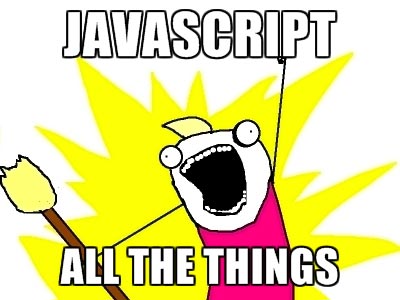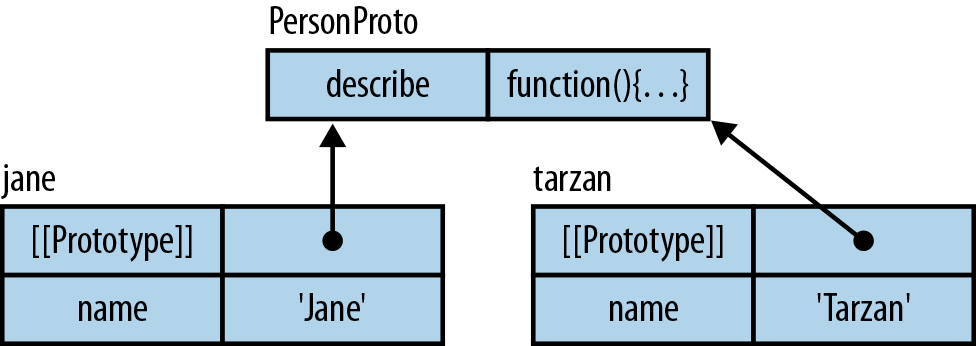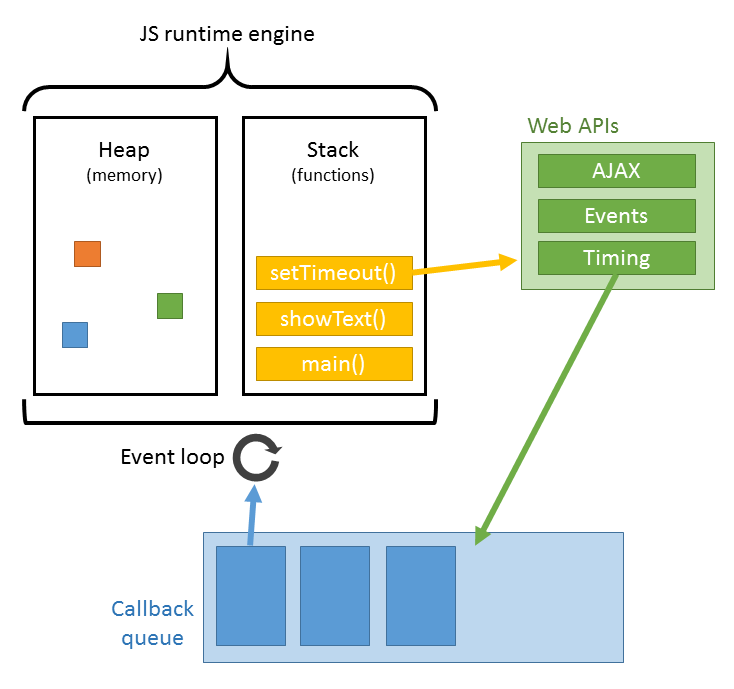JavaScript Overview
Attention! Code ahead!

Attention! Code ahead!
The bad parts
"Some of the worst ideas in the history of programming languages can be found in JavaScript"
-- Douglas Crockford
"Perhaps my perspective is skewed, because I've seen the real WTFs in JavaScript"
-- Kyle Simpson
The bad parts
- global scope
- eval, with, void
- type coersion
- arguments meta parameter
- function statment vs expression
- incorrect math
- users run different versions
Bad parts
//local variable
var a = 5;
//implicit global
b = 10;
//globals are accessible to any script on the page
window.a // undefined
window.b // returns 10
//Bad math
0.1 + 0.2 === 0.3 // false
Number.MIN_VALUE > 0 // true
//function weirdness
function () {} // SyntaxError
var f = function () {} // no problem
//arguments meta parameter
(function (a) {
// a = 1
arguments[0] = arguments[1];
// a = 2
}(1, 2));
Bad parts
//type weirdness
typeof null // object
typeof (new String('abc')) // object
typeof 'abc' //string
typeof (new Boolean(true)) //object
typeof true //boolean
typeof (new Array()) //object
typeof [] // object
typeof (new Function()) // function
typeof function () {} // function
//Type coersion
if ([]) { doStuff(); } // gets called
if ([] == true) { doStuff(); } // DOSN'T get called
if ([] === false) { doStuff(); } // DOSN'T get called
Bad parts
hello //Error: hello is not defined
hello! //SyntaxError: Unexpected token !
//statment position
function () {} //SyntaxError: Unexpected token (
(function () {}) //returns the function
function f() {} //returns undefined, but f is defined
function f() {}, 'hi' //SyntaxError: Unexpected token ,
(function f() {}, 'hi') //"hi"
//Any much more..
The hard parts
- async and event loop
- prototypal inheritance
- this, scope and common pitfalls
- tooling
- execution context
Prototypical inheritance

The event loop

The good parts
- Flexible Objects
- Flexible Functions
- Lexical Closure
- OOP & Functional
- Modern engines
ES2015: The new parts
- JavaScript language specification, released in June 2015
- Incrementally implemented in browsers and other environments
- Introduces a plethora of new features and improvements
Some of the new features in ES2015
- Arrow functions
- Classes
- Object literals syntax
- Destructuring
- Default parameters
- Array spreading
- Variable declarations
- Generators
- Promises
- Iterators
- Symbols
- Number methods
- Template strings
- Sets
- Maps
- WeakMap

Variable declaration
//es5
function incCounter() {
counter += five;
if (false) {
var five = 5;
}
//logical error! - the value of five is undefined
}
var counter = 0;
//this code "works" because of var hoisting
//es6
if (condition) {
let j = 12; //j exists only inside the if block
}
console.log(j); //throws an Error
const pi = { value: 3.14 }; //pi cannot be reassigned
pi = 3.14; //throws an Error
//we can still change properties of the object
pi.value = 4;
//the "me" object cannot be changed
const me = Object.freeze({ name: 'Mihail' });
How do const and let help?
- Clear intent
- Block scope (const, let)
- Immutable binding (const)
Arrow functions
//es5
[1, 2, 3, 4].map(function square(i) {
return i*i;
}); // [1, 4, 9, 16]
getNumbersAsync(function callback(a, b) {
return a + b;
});
fancyObject.coolMethod = function () {
var self = this;
this.elements.forEach(function (el) {
self.processElement(el); //different "this", use self
});
}
//es6
[1, 2, 3, 4].map(i => i*i); // [1, 4, 9, 16]
getNumbersAsync((a, b) => a + b);
fancyObject.coolMethod = () => {
this.elements.forEach(el => {
this.processElement(el);
//error! - "this" doesn't point to fancyObject
});
}
How do arrow functions help?
- Concise & Clear intent
- Uses the outer scope's "this"
- No arguments meta parameter
- Not a full substitute of functions
Classes
//es5
function Car(model, color) {
this.model = model;
this.color = color;
}
Car.prototype.startEngine = function () {
return "Started the engine of the " + this.model;
};
var myCar = new Car('Tesla', 'white');
//es6
class Car {
constructor(model, color) {
this.model = model;
this.color = color;
}
startEngine() {
return "Started the engine of the " + this.model;
}
}
let myCar = new Car('Tesla', 'white');
How do classes help?
- All declarations stay together
- Methods on the prototype by default
Object literals syntax
//es5
var name = 'Mihail',
myObject = {
name: name,
getFriends: function () { ... }
};
myObject[getPropertyName()] = 'some value';
//es6
let name = 'Mihail',
myObject = {
name,
getFriends() { ... },
[getPropertyName()]: 'some value'
};
How does object literals syntax help?
- Compact & clear intent
- All declarations stay together
Destructuring
//es5
var coordinates = [23, 14],
x = coordinates[0],
y = coordinates[1];
var personalInfo = getPersonalInfo(),
name = personalInfo.name,
age = personalInfo.age,
petName = personalInfo.pet.name;
//es6
let [x, y] = [23, 14];
let { name, age, pet: { name: petName } } = getPersonalInfo();
//with function parameters
function sayHi({ name }) {
console.log('Hi, ' + name);
}
sayHi(getPersonalInfo());
How does destructuring help?
- Clear intent
- Pattern Matching
Array spreading
//es5
function variableNumberOfArguments() {
//hack to get the arguments as an array
var args = Array.prototype.splice.call(arguments, 0);
}
var numbers = [1, 2, 3],
letters = ['a', 'b', 'c'],
both = numbers.concat(letters);
//es6
function variableNumberOfArguments(...args) {
//args is already an array with all arguments
}
let numbers = [1, 2, 3],
letters = ['a', 'b', 'c'],
both = [...numbers, ...letters];
How does spreading help?
- Concise and composable
- No need for the "arguments" parameter
Default parameters
//es5
function makeCaption(text, style) {
text = text || 'default caption';
style = typeof style === 'object' ? style : { color: 'red' };
myH1.style.color = style.color;
myH1.text = text;
}
//es6
function h1(text = 'text', { color } = { color: 'red' }) {
const myH1 = document.createElement('h1');
myH1.style.color = color;
myH1.textContent = text;
return myH1;
}
How do default parameters help?
- Readability
- Prevents undefined behaviour
Template strings
//es5
"A " + car.color + " " + car.model + " just drove by"
//es6
`A ${car.color} ${car.model} just drove by`
How do template strings help?
- Built-in template engine
- Customizable through functions
Sets & Maps
//es6
//Sets
var key = 'any type of value',
set = new Set();
set.add(key);
set.delete(key);
set.has(key) //returns true or false
//Maps
let key = { a: 1 },
value = { b: 2 },
map = new Map();
map.set(key, value);
map.delete(key);
map.get(key); //returns value
How do sets & maps help?
- Ability to relate any values types
- No more abusing objects and arrays
for sets and maps - WeakMap and WeakSet help stop memory leaks
- Built-in implementations improve performance
Promises
//es6
//how to create a promise
let getData = (url) => new Promise((resolve, reject) => {
ajax(url, (error, data) => {
if (error) {
reject(error);
} else {
resolve(data);
}
});
});
//using the promise
getData('http://somesite.com/data')
.then(doSomethingClever)
.catch(logError);
Promises
//es6
//chaining promises
getNumbersAsync()
.then(([a, b]) => a + b)
.then(checkSumWithServer)
.then(handleServerResponse)
.catch(logError);
//promise helper methods
Promise.resolve(value) //returns a "thenable" promise
Promise.reject(error) //returns a "catchable" promise
Promise.all([array, of, promises]) // waits for all
Promise.race([array, of, promises]) //the first to resolve wins
How do promises help?
- Clear and natural API
- Reduce callback hell
- Future value semantics
- Invert the flow of control
- Basis for implementing the async/await pattern
Generators
//es6
function* squaresMaker() {
let i = 1;
while (true) {
let step = yield i*i;
i += step || 1;
}
};
let squares = squaresMaker();
squares.next(); // { value: 1, done: false }
squares.next(); // { value: 4, done: false }
squares.next(); // { value: 9, done: false }
squares.next(2); // { value: 16, done: false }
//step = 2
squares.next(); // { value: 36, done: false }
How do generators help?
- State machine inside a function
- Two way message passing
- Co-routines and flow of control
- Basis for implementing the async/await pattern
Async/Await
//es7
async function combinedQuery() {
let firstAnswer = await firstQuery(),
secondAnswer = await secondQuery(firstAnswer);
return secondAnswer;
}
//use inside another async function
async function useQueryAsync() {
let answer = await combinedQuery();
doSomethingClever(answer);
}
//or use the result as a promise
function useQuery() {
combinedQuery().then(doSomethingClever);
}
Annotations
//es7
let myObject = {
//built-in annotation
@readonly
myConstant: 42
};
myObject.constant = 7; //throws an error
//annotation definitions are just functions
function authorized() { ... }
//using our custom annotation
@authorized
function getData() { ... }
WebAssembly
- A byte-code for the web
- Decouples the language from the runtime
- Compiled from many languages
Links:
Course Schedule:
| week 1 03.02.2017 | History of the web | Fullstack Principles | Development Processes | Agile Processes | DevOps Basics | Git |
| week 2 10.02.2017 | Frontend Overview | Backend Overview | Network Overview | Testing | JavaScript Overview | JavaScript Tooling |
| week 3 17.02.2017 | Web Architectures | RESTful principles | SOLID principles | Web Components | Continuous Integration | |
| week 4 24.02.2017 | Databases basics | Using APIs | Deployment Automation | Monitoring | In-class project consultations | |
| week 5 17.03.2017 |
Project presentations Final Test Course Retrospective and Q&A |
|||||